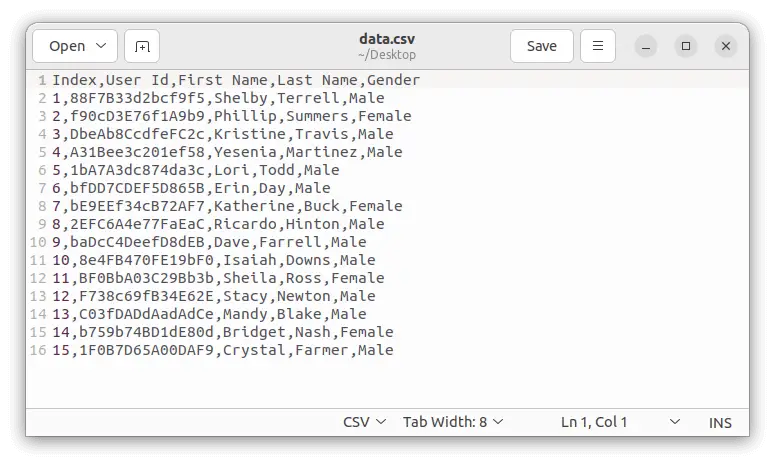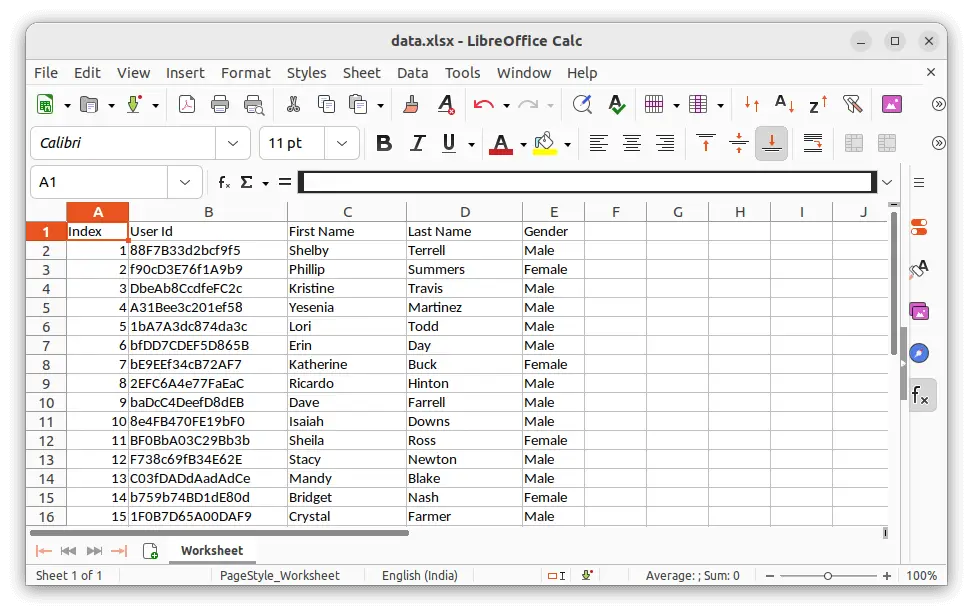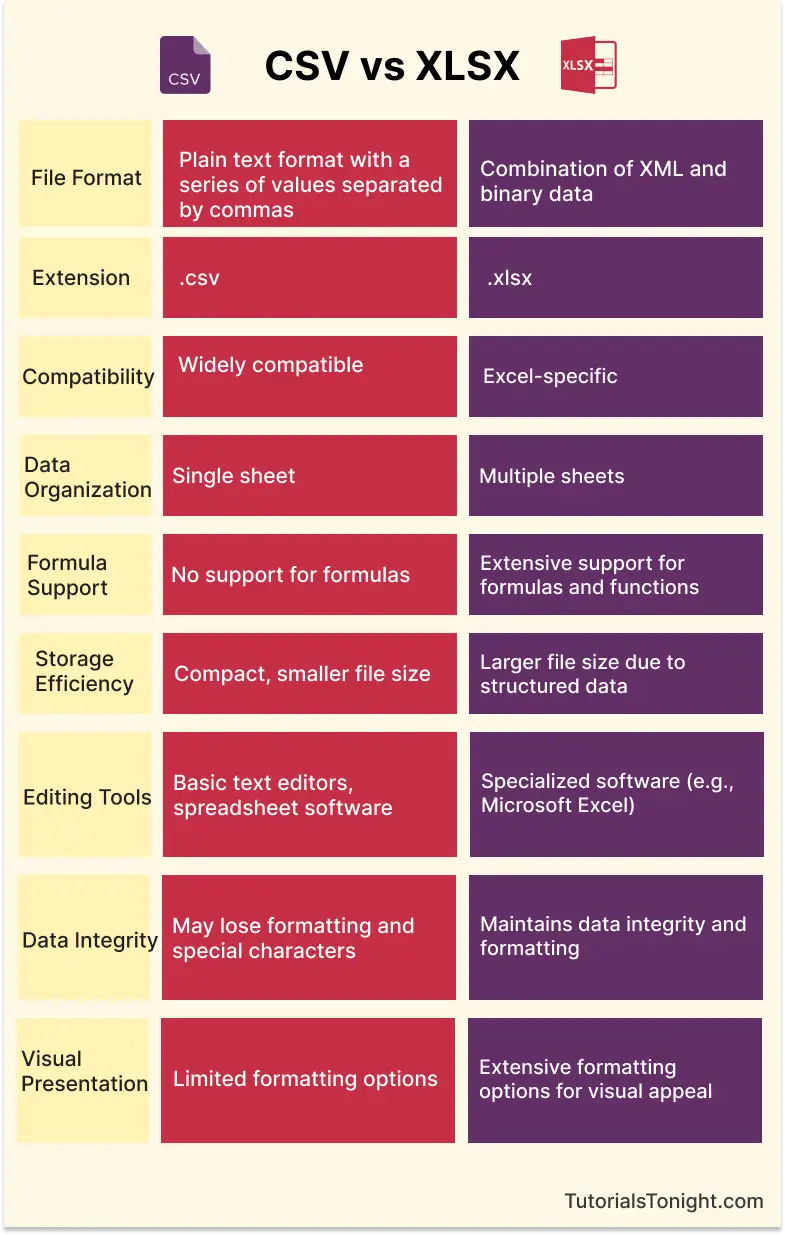CSV vs XLSX - Difference Between CSV and XLSX
Data management is a crucial part of any organization. It is stored in various formats and is used for various purposes. Two of the most popular formats for storing data are CSV and XLSX.
They have their own advantages and limitations, similarities and differences. In this article, we will discuss the difference between CSV and XLSX.
- What is CSV
- What is XLSX
- Difference between CSV and XLSX
- Conclusion
Table of Contents
What is CSV?
CSV stands for Comma-Separated Values. It's a simple, text-based format used for storing and exchanging tabular data.
Each line of the file is a data record. Each record consists of one or more fields, separated by commas. The use of the comma as a field separator is the source of the name for this file format.
CSV files are most popular choice for moving tabular data between two different computer programs, for example, between a database program and a spreadsheet program.

Advantages of CSV
- CSV files have simple and straightforward text-based files, which makes them easy to read and edit.
- Due to simple structure, it is easy to create and edit CSV files.
- Smaller file size as compared to other file formats.
- CSV files are supported by almost all spreadsheet programs and database management systems.
- These are easy to import and export from one program to another.
Limitations of CSV
- No data type - There is no data type associated with the values in CSV files. All values are treated as strings.
- No formatting - CSV files do not support formatting (like color, style), formulas, and other features.
- No multiple sheets - CSV files do not support multiple sheets or tabs within a single file, limiting their ability to represent complex datasets.
- No data validation - CSV lacks built-in data validation making it prone to errors.
- No images - Support for images or graphics is not available in CSV files.
What is XLSX?
XLSX is a file extension for an open XML spreadsheet file format used by Microsoft Excel. It is a default file format for Excel 2007 and later versions.
XLSX is based on the XML standard and consists of worksheets with rows and columns. The file contains a combination of XML and binary data. XLSX files are compressed to reduce file size.
XLSX is a file format associated with Microsoft Excel but can be opened and edited by other spreadsheet software applications.

Advantages of XLSX
- Rich functionality - XLSX files support a wide range of features, including formulas, functions, graphs, conditional formatting, and advanced data manipulation options. This makes it a powerful tool for complex data analysis and reporting.
- Multiple sheets - XLSX files support multiple sheets or tabs within a single file, allowing you to represent complex datasets.
- Data Validation and Formatting - XLSX provides extensive support for data validation, allowing users to define rules and constraints on data input. It also offers advanced formatting options to enhance the visual appearance of the spreadsheet.
Limitations of XLSX
- Large file size - XLSX files are larger in size as compared to CSV files.
- Complexity - Advance features of XLSX files make them complex to create and edit.
- Size limitations
- Maximum capacity: 1,048,576 rows and 16,384 columns per sheet.
- 32,767 Character Limits Per Cell.
- Maximum recommended size: 50MB for optimal performance.
Difference between CSV and XLSX
The following table summarizes the differences between CSV and XLSX.
| Feature | CSV | XLSX |
|---|---|---|
| File Format | Text-based | Combination of XML and binary data |
| Extension | .csv | .xlsx |
| Compatibility | Widely compatible | Excel-specific |
| Data Organization | Single sheet | Multiple sheets |
| Cell Types | Limited to text, numbers, and symbols | Supports various data types and formatting |
| Formula Support | No support for formulas | Extensive support for formulas and functions |
| Storage Efficiency | Compact, smaller file size | Larger file size due to structured data |
| Editing Tools | Basic text editors, spreadsheet software | Specialized software (e.g., Microsoft Excel) |
| Data Integrity | May lose formatting and special characters | Maintains data integrity and formatting |
| Usage Flexibility | Easier for basic data exchange | More suitable for complex data manipulation |
| Visual Presentation | Limited formatting options | Extensive formatting options for visual appeal |
| Platform Independence | Universally readable | Excel-dependent |
| Data Security | No built-in security features | Supports password protection and encryption |
| Performance | Faster processing due to simplicity | Slower processing due to complex structure |
| Software Dependencies | Fewer dependencies on specific software | Relies on Excel or software compatible with XLSX |
| Import/Export Capabilities | Seamless integration across applications | May encounter compatibility issues with some software |
| File Size Limitations | None | Maximum capacity: 1,048,576 rows and 16,384 columns per sheet. |
| Best Suited For | Basic data exchange | Complex data manipulation |
Here is infographic representation of the difference between CSV and XLSX.

Conclusion
Both CSV and XLSX are popular file formats but the choice between them depends on the purpose of use:
- If simplicity, lightweight file size, and cross-platform compatibility are important, CSV may be the better option.
- If advanced functionality, data validation, complex formulas, and rich formatting options are required, XLSX is the preferred choice.
